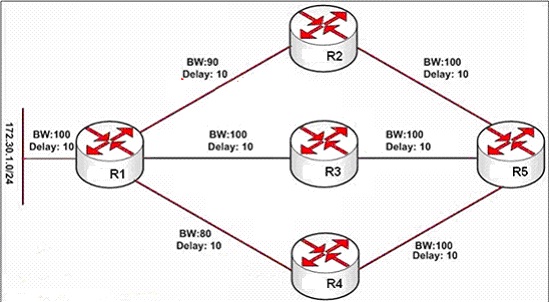- Cisco Community
- Technology and Support
- Networking
- Routing
- Re: EIGRP AD RD & FD
- Subscribe to RSS Feed
- Mark Topic as New
- Mark Topic as Read
- Float this Topic for Current User
- Bookmark
- Subscribe
- Mute
- Printer Friendly Page
- Mark as New
- Bookmark
- Subscribe
- Mute
- Subscribe to RSS Feed
- Permalink
- Report Inappropriate Content
02-06-2013 03:21 AM - edited 03-04-2019 06:57 PM

Hi All,
While studying about EIGRP I found this diagram online & was confused by the description of how EIGRP chooses its best route...
Can some one please tell from the diagram, what would be the Advertised Distance, Reported Distance & Feasible Distance for the network 172.30.1.0/24 at R5 from each of R2, R3, & R4. Who would/wouldn't be the successors & feasible successors & why?
Thanks a lot in advance
Solved! Go to Solution.
- Labels:
-
Routing Protocols
Accepted Solutions
- Mark as New
- Bookmark
- Subscribe
- Mute
- Subscribe to RSS Feed
- Permalink
- Report Inappropriate Content
02-06-2013 05:59 AM
Hello Pradeep,
In order to answer this question, you have to compute the resulting EIGRP metric from these component metrics, and compare the resulting numbers.
The formula to compute EIGRP metrics from individual components in default configuration is:
Metric = [ (10^7 DIV minBW) + Delay ] * 256
where DIV is an integer division (perform the normal division and take the integral part, throwing the fraction away).
So let's see:
- [ (10^7 DIV 90) + 30 ] * 256 = 28452096
- [ (10^7 DIV 80) + 20 ] * 256 = 32005120
- [ (10^7 DIV 70) + 10 ] * 256 = 36573952
Obviously, the path with BW=90, Delay=30 wins.
Best regards,
Peter
- Mark as New
- Bookmark
- Subscribe
- Mute
- Subscribe to RSS Feed
- Permalink
- Report Inappropriate Content
02-06-2013 03:28 AM
Just in case if the diagram is not clear:
R1 to R2 : BW=90 ; Delay=10
R1 to R3 : BW=100 ; Delay=10
R1 to R4 : BW=80 ; Delay=10
R2 to R5 : BW=100 ; Delay=10
R3 to R5 : BW=100 ; Delay=10
R4 to R5 : BW=100 ; Delay=10
- Mark as New
- Bookmark
- Subscribe
- Mute
- Subscribe to RSS Feed
- Permalink
- Report Inappropriate Content
02-06-2013 03:29 AM
Hello Pradeep,
Remember the following definitions:
- Feasible Distance is the lowest known distance to the destination since the last transition of that destination from Active to Passive state. Feasible Distance may therefore be equal to the current lowest distance to the destination, or, in certain circumstances, it may also be lower than the current distance.
- Reported Distance is the distance advertised (reported) by a neighbor. The terms Advertised Distance and Reported Distance are identical and they both describe the same thing. It is, however, recommended not to use the term Advertised Distance because its acronym AD get easily confused with administrative distance which is a totally unrelated concept.
So for R5, the distances would be:
- Reported from R2: BW=90, Delay=20
- Reported from R3: BW=100, Delay=20
- Reported from R4: BW=80, Delay=20
Total distances must also take the links between R5 and R2/R3/R4 into account, i.e.:
- Total via R2: BW=90, Delay=30
- Total via R3: BW=100, Delay=30
- Total via R4: BW=80, Delay=30
The lowest total distance of R5 towards 172.30.1.0/24 will be through R3 which will initially also become the Feasible Distance.
Best regards,
Peter
- Mark as New
- Bookmark
- Subscribe
- Mute
- Subscribe to RSS Feed
- Permalink
- Report Inappropriate Content
02-06-2013 05:44 AM
Hi Peter,
Thanks for the reply. But If i have 3 different routes like this:
BW=90 Delay=30
BW=80 Delay=20
BW=70 Delay=10
which one is better? & why?
- Mark as New
- Bookmark
- Subscribe
- Mute
- Subscribe to RSS Feed
- Permalink
- Report Inappropriate Content
02-06-2013 05:59 AM
Hello Pradeep,
In order to answer this question, you have to compute the resulting EIGRP metric from these component metrics, and compare the resulting numbers.
The formula to compute EIGRP metrics from individual components in default configuration is:
Metric = [ (10^7 DIV minBW) + Delay ] * 256
where DIV is an integer division (perform the normal division and take the integral part, throwing the fraction away).
So let's see:
- [ (10^7 DIV 90) + 30 ] * 256 = 28452096
- [ (10^7 DIV 80) + 20 ] * 256 = 32005120
- [ (10^7 DIV 70) + 10 ] * 256 = 36573952
Obviously, the path with BW=90, Delay=30 wins.
Best regards,
Peter
Discover and save your favorite ideas. Come back to expert answers, step-by-step guides, recent topics, and more.
New here? Get started with these tips. How to use Community New member guide
